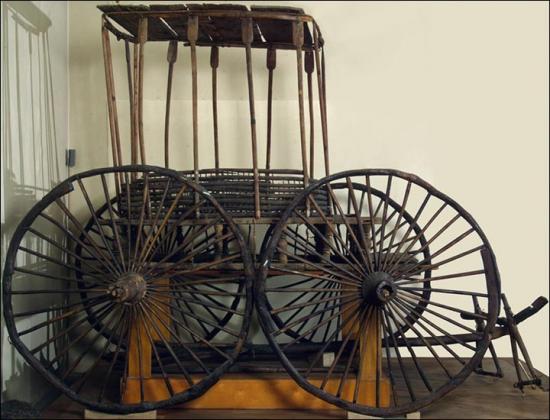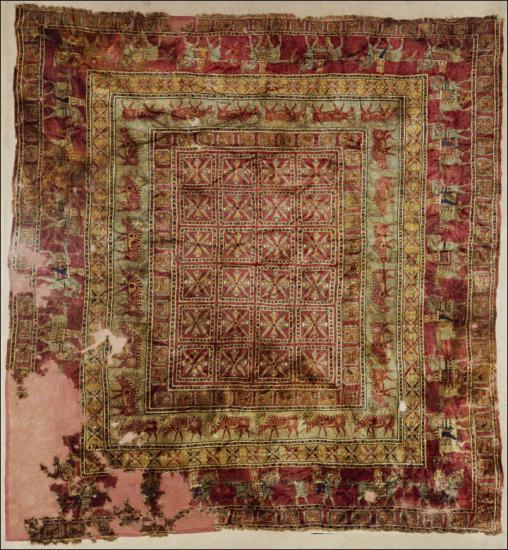Source - http://siberiantimes.com/science/casestudy/news/n0861-tattooed-owners-of-the-worlds-oldest-carpets-get-health-check-after-2200-years/
Mummified potentate and wife were found in burial mound 42 metres in diameter, and they went to the next life alongside 9 geldings, saddled and harnessed.
 Tattooed owners of the world's oldest carpets get health check after 2,200 years. Picture: Dmitry Koshcheev
Tattooed owners of the world's oldest carpets get health check after 2,200 years. Picture: Dmitry Koshcheev
New technology has been used to obtain the secrets of two ancient mummy's excavated from their graves in the Altai Mountains in 1949.
The pair are seen as a local chieftain from the Pazyryk culture and his wife or concubine who was incarcerated alongside him, evidently with cannabis burning in the burial chamber.
Their remains - preserved because they were encased in ice for thousands of millennia in the valley of the River Bolshoy Ulagan - are held in the Hermitage Museum in St Petersburg.
 This scan is the first of its kind for the world famous Hermitage. Picture: The State Hermitage Museum
This scan is the first of its kind for the world famous Hermitage. Picture: The State Hermitage Museum
Now the body of the curly-haired male, between 55 and 60 when he died, and the woman, some ten years younger, have been scanned to create tomograph images using a Siemens SOMATOM Emotion in 16 separate modes.
Multi-disciplinary analysis will be undertaken including radiologists, biological anthropologists, archaeologists and other scientists, with the results announced later.
This scan is the first of its kind for the world famous Hermitage. The aim is to establish the cause of death, and reconstruct the appearance of the ancient pair, and to study the techniques of mummification in more detail.
Most of the treasures of the grave were robbed in prehistoric times, but famously two carpets remained - which are the oldest in the world. They contain remarkable images - shown in these striking pictures - of life in the Pazyryk era in Siberia.
Inside the vast mound was a wooden burial chamber covered with logs. In the larch sarcophagus lay the two bodies, on which are intriguing tattoos.
Soviet archeologist Sergey Rudenko - who led the excavation - wrote after his discovery: 'Both the man and woman were of Caucasoid type.

 Exhibition with the findings from the burial mound in Hermitage. Male body. Cahriot. Pictures: KunstWerk, Dmitry Koshcheev, The State Hermitage Museum
Exhibition with the findings from the burial mound in Hermitage. Male body. Cahriot. Pictures: KunstWerk, Dmitry Koshcheev, The State Hermitage Museum
'Their hair was soft, the man's a little curly and dark. The woman's dark brown. Their faces were long and narrow, the man had a sharply protruding aquiline nose.
'The man's head, except for the back, was shaved. The woman's head was also shaved, except that on top was a pigtail.
'Both bodies were mummified, using the same method. The skulls were trepanned and the brain was removed. Through a slice in the abdomen, from the ribs to the groin, the intestines were removed.
'In addition, through special sections of the chest, back, arms and legs were removed all the muscles of the body, so that remaining was only the skeleton and skin.'
The burial ritual then involved restoring the shape of the human form by stuffing the remains with horsehair. The cuts in the skin were also sewn with horsehair.
Archeologists found traces of an incense burner, sheep and goat skins, and shards of pots.
 The world earliest pile-woven carpet. Pictures: The State Hermitage Museum
The world earliest pile-woven carpet. Pictures: The State Hermitage Museum
Guarding the burial chamber were nine horses - all geldings - with saddles and complete harnesses, decorated with wooden figurines of griffins, a lion or tiger, a saiga antelope, deer and felt.
Undisturbed lay two precious carpets, the most ancient ever found. One was made of felt - some 4.5 by 6.5 metres in size, probably originally a wall hanging.
It was decorated with multi-colour applique including sewn figures more than 1 metre in height, carved from fine coloured felt. The central scene shows a rider approach a throne on which is seated a goddess with a flowering branch in her hand.
PART.2